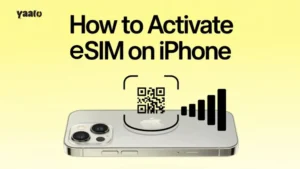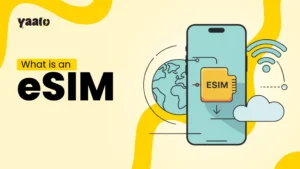Did you know that the world’s first SIM card was the size of a credit card? SIM card has a long history; the concept of SIM cards originated in the 1960s. The first SIM generation evolved with time, and now we are using the most modified form of technology in our devices, like eSIM cards. Such changes in telecommunication positively impact our lives, and now we can enjoy smooth communication throughout the borders. How did this evolution happen over time?
In this article, I will go through the details of SIM cards and how they have evolved with time and made effortless global communication possible.
What is a SIM card?
SIM card is the subscriber identity module that stores the user’s mobile identity and authenticates their mobile devices. It is a plastic card chip that contains a processor and memory circuit for information, including subscriber network plan, text messages, contacts, and other details. It includes the number that makes it possible for the users to make calls.
How does a SIM card work?
A traditional SIM card contains unique identity information like IMSI (International Mobile Subscriber Identity) and an ICCID (Integrated Circuit Card Identifier). IMSI works to verify the user’s phone security and connect it to the service network. ICCID secures your information, like services and passwords.
History of SIM Card
The subscriber identity module has a long history, like mobile communication.
First SIM cards had the size of a credit card, called 1 FF or 1st Form Factor, which shrank to 2FF mini-SIM. But still, the SIM size was larger and had more potential to be smaller; experts worked on it and minimized its size to micro SIM, 3FF, and nano SIM, 4FF.

How have SIM cards evolved?
Here is the concise information about the multiple SIM card history for your understanding.
First SIM Card
The first SIM card was originated by Munich smart-card maker Giesecke+Devrient in 1991. After some experiments, 300 SIM cards were sold to a Finnish wireless network operator, Radiolinja. The SIM card had a big size, but it made it possible for devices to connect to cellular networks for communication.
Mini-SIM Card
After the innovation of the SIM card, experts worked on minimizing the SIM card sizes to provide mobile phones more space for more functionalities. In 1996, the first mini SIM was launched, which had a small size compared to the 1FF. The smaller-sized SIM gives more space to improve the battery size of the device.
Micro-SIM
After some time, mini-SIM evolved into a micro SIM card. The first micro SIM card was launched in 2010; it was more efficient and functional than 1FF. iPhone 4 has the credit of being the first micro SIM compatible device.
Nano-SIM
Nano-SIM is the smallest physical chip card that comes after micro-SIM. It is the finest modified form of physical SIM that is mostly used in our devices nowadays.
eSIM Card
eSIM is a digitalised SIM card that is installed into devices by manufacturers. Embedded SIM has no physical appearance, and it can’t be removed from the device. Compared to the physical SIM card, it offers a convenient and flexible data connection. It offers remote QR code activation with instant connectivity.
iSIM
iSIM is the integrated SIM card that is built in device software. It is the most digitalized form of SIM cards that offer more security and digitally store users’ information.
Dual SIM Technology
Times ago, devices sold in the market with a single SIM card support. But now, most of the devices have a dual SIM nature that allows you to use two or three physical SIM cards in a single device. The latest models of dual SIM smartphones allow you to use an eSIM with a SIM card or allow you to use two eSIMs at the same time. Dual SIM devices are best for travelers to avoid the hassle of having more than one device. It allows them to use eSIM for data connection and physical SIM.
Conclusion
SIM card has a history rooted in the 1900s. The first SIM was a big-sized SIM card that took up more space in the device, which affected the battery size. After a while, the SIM card size is minimized to mini and micro SIM.
Well, it was a great relief, and experts added more functions to devices. The journey didn’t stop, and with the emergence of technology, SIM became modified into a digital chip. Nowadays, eSIM and iSIMs are the most advanced technologies used in your device that improve our communication without the hassle of location and time.
The world is becoming more advanced, and our means of comfort are developing with time. Thus, we can expect the extinction of physical SIM cards and a massive shift in technology in the near future. When you need to shift, Yaalo eSIM is the best choice you can rely on!
FAQs
What is the future of SIM cards?
According to experts’ reviews, traditional SIMs will be replaced with physical SIM cards in the near future. Most smartphone companies have launched eSIM-supported devices. Due to its convenience and flexibility, eSIM is becoming the leading connectivity mode used worldwide.
How has SIM card technology developed over time?
The first Universal Subscriber Identity Module was designed for 3G UMTS networks to enhance security and storage. After the Universal Integrated Circuit Card, SIM cards evolved into other varieties: mini-SIM, micro-SIM, and nano-SIM. eSIM card and iSIM are the latest digitalized form of SIM card.
- How to Activate eSIM on iPhone: 4 Easy Methods (2025 Guide) - October 15, 2025
- Top 5 Scholarships for Spain in 2025 - October 1, 2025
- What is an IMEI Number and How to Find it? - September 23, 2025








